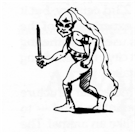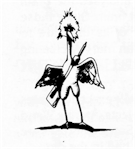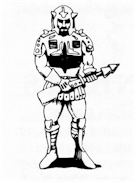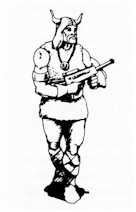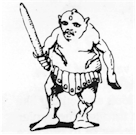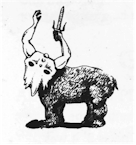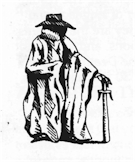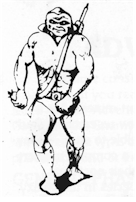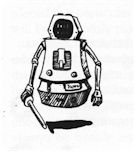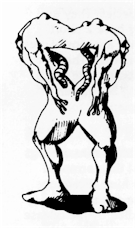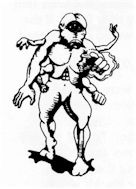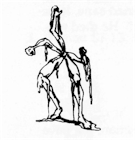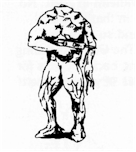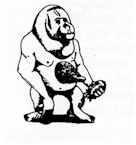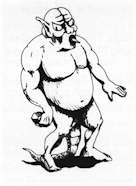GALACTIC ADVENTURES
Box (back and front), manual cover, and reference card:
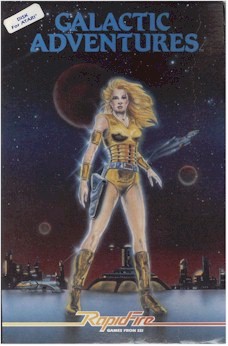
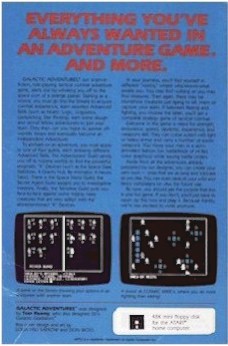
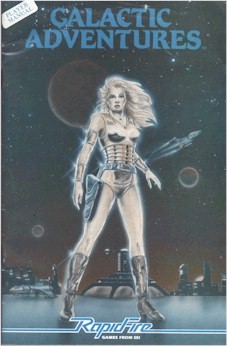
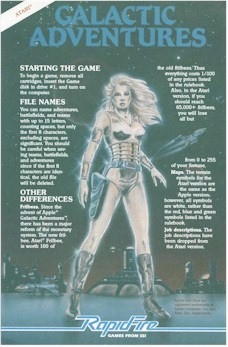
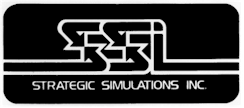
GALACTIC ADVENTURES PLAYER MANUAL
If you have any questions or problems regarding the program or game, please send a
self-addressed, stamped envelope with your question to Strategic Simulations, lnc.,
465 Fairchild Drive, Suite 108, Mountain View, CA 94043.
LIMITED WARRANTY
Strategic Simulations. Inc. ("SSI") warrants that the diskette on which the enclosed program is recorded will be free from defects in materials and workmanship for a period of 30 days from the date of purchase. If within 30 days of purchase the diskette proves defective in anyway. you may return it to Strategic Simulations, Inc., 465 Fairchild Drive, Suite 108. MountaIn View. CA 94043 and SSI will replace it free of charge. In addition. if the diskette proves defective at any time after the first 30 days. return the diskette to SSI and SSI will replace it for a charge of $10.00. Please allow about four weeks for delivery.
SSI MAKES NO WARRANTIES, EITHER EXPRESS OR IMPLIED. WITH
RESPECT TO THE SOFTWARE PROGRAM RECORDED ON THE DISKETfE OR THE GAME DESCRIBED IN THIS RULE BOOK, THEIR
QUALITY. PERFORMANCE, MERCHANTABILITY OR FITNESS FOR
ANY PARTICULAR PURPOSE. THE PROGRAM AND GAME ARE SOLE)
"AS IS." THE ENTIRE RISK AS TO THEIR QUALITY AND PERFORMANCE IS WITH THE BUYER. IN NO EVENT WILL SSI BE LIABLE FOR
DIRECT, INDIRECT, INCIDENTAL, OR CONSEQUENTIAL DAMAGES
RESULTING FROM ANY DEFECT IN THE PROGRAM OR GAME EVEN
IFSSI HAS BEEN ADVISED OFTHE POSSIBILITY OFSUCH DAMAGES.
(SOME STATES DO NOT ALWW THE EXCLUSION OR LIMITATION OF
IMPLIED WARRANTIES OR LIABILITY FOR INCIDENTAL OR CONSEQUENTIAL DAMAGES. SO THE ABOVE LIMITATION OR EXCLUSION
MAY NOT APPLY TO YOU.)
The enclosed software program and this Rule Book are copyrighted. All rights are reserved. This Rule Book may not be copied. photographed. reproduced. or translated or reduced to any electrical medium or machine-readable form, in whole or in part without prior written consent from SSI. The program accompanying this Rule Book may be copied by the original purchaser only as necessary for use on the computer for which it was purchased.
© 1982 by Strategic Simulations, Inc.
All Rights Reserved.
All Rights Reserved.
TABLE OF CONTENTS
STARTING GALACTIC ADVENTURESINTRODUCTION
CHARACTERS OF GALACTIC ADVENTURES
OBJECTS AND DEVICES OF GALACTIC ADVENTURES
HOME SYSTEMS OF GALACTIC ADVENTURES
Visitor's Center
Space Port
Space Travel in Galactic Adventures
Notes on Space Travel
Guild Area
The Streets
Meeting Displays
Jobs
Job Skill Game
COMBAT RULES OF GALACTIC ADVENTURES
Combat Turn
Battlefield Displays
Placement
Visibility
Combat Options
Movement Rules
Null Gravity
Two-Player Option
End of Combat Options
Combat Formulas
ADVANCED SKILLS & TOOLS OF GALACTIC ADVENTURES
Object Skills
People Skills
K DEVICES OF GALACTIC ADVENTURES
SPECIES OF GALACTIC ADVENTURES
Regular Species
Special Species
ADVENTURES OF GALACTIC ADVENTURES
Adventure Places
Adventure Types
ADVENTURE CONSTRUCTION
General Phase
Battlefield Phase
Enemy Band Phase
Job Descriptions
DESIGNER'S NOTES
General Approach
Starting Out in Life
Applying for Adventures
Creating Adventures
Old Battlefields and Teams
When Adventure Bands Meet
Galactic Adventures as Interactive Science Fiction
Adventure Places
HISTORICAL BACKGROUND
The Agency
The Space Patrol
Adventurer's Guild
Sensitive's Guild
PLAYING AIDS
SPACE SHIPS & CONTROLS
BATTLEFIELDS
14 x 8 BATTLEFIELD GRID
17 x 10 BATTLEFIELD GRID
28 x 16 BATTLEFIELD GRID
COMBAT OPTIONS
Team Options
Individual Options
K DEVICES AND EFFECTS
CHARACTER SHEET
SPECIES CHARACTERISTICS
CREDITS
WEAPON & ARMOR TABLES
STARTING GALACTIC ADVENTURES
Galactic Adventures contains two disks, the game disk and the adventure disk. The game disk should be inserted in drive #1, and if you have two drives, the adventure disk should go in drive #2. If you have one drive, leave the adventure disk alone until you are told to insert it in drive #1. To begin a game, boot the game disk (insert the disk in drive #1 and turn on the computer) and the game will automatically begin. If you are using an Apple II with PASCAL, you must use your Basics disk. If you are using an Apple III, you must first go into Apple II emulation mode. After you boot, you ll be greeted by a menu which will allow you to initialize, catalog, or delete files from an SSI save disk, restart an old game, start a new game. construct an adventure place, create your own job descriptions, or practice flying space ships. These functions are explained later in the rules. For now, just choose a new game. Note: If you are planning to save the game, be sure you have an SSI initialized disk before beginning.INTRODUCTION
Galactic Adventures is a science fiction role-playing game and adventuring system. You start out with a single character (from one of seven regular species), and can add up to 9 additional, individually defined followers. All characters start in their home system, Star Date 2918.1, with a Transport Cyborg and 30,000 Frilbees (the standard interstellar currency).Armed with this basic stake, and a few weapon and advanced skills, the player guides their character through life in the interstellar society of the 30th century. This life, at first, consists primarily of meetings with an ever-changing variety of your fellow creatures, including some very strange ones. These meetings are your source for money (job offers and seffing rare items), skill advancement (job offers and RNA tabs) and, most importantly, fellow adventurers. You can get followers by hiring them from the creatures you meet or by buying a special species, for example, a warrior robot.
After you've gotten a band of adventurers together, equipped them, and trained them, you'll be ready for the next step -- taking them out on an adventure. These adventures can vary from exploring strange alien worlds for the Adventurer's Guild to working on cases for the Agency or the Space Patrol to visiting the ancient sites of a vanished race for the Sensitive's Guild to whatever your imagination can devise.
If you survive your first adventure, you'll become a Trial Adventurer. This is just the first step on the road to the highest honor: the title of Independent Adventurer. There are many possible paths to the top, but they are all long, dangerous, and exciting.
Galactic Adventures, in addition to being a role-playing game, is an adventuring system. The various home systems and existing adventures provide a framework within which you can create your own adventures. These adventures can include actMties such as piloting your own space ship through a hyper-gate; space battles with Gorsai pirates; hand-to-hand combat with such creatures as berserk robots, the Mole People, mutants, and anything else you want to create; and performing jobs ranging from picking a lock to working with a quantum black hole. In addition, since adventures can be linked together, you can create adventures as complex as you want.
CHARACTERS OF
GALACTIC ADVENTURES
All characters in Galactic Adventures have a numerical rating for each of the eight personal characteristics listed below, and for various weapon skills and advanced skills.ST-STRENGTH Normal range is 6 to 20. Strength determines the weapons and armor that can be used in combat, the amount of damage that can be sustained, and the amount of damage it takes to stun a character.
DX-DEXTERITY Normal range is 6 to 20. Dexterity determines the order of attacks (highest adjusted dexterity attacks first) and, along with weapon skills, the probability of hitting an opponent.
EN-ENDURANCE Normal range is 3 to 11. Endurance is reduced by damage points and by using a hand weapon in an attack. If endurance falls to 0 or less, the character must rest, which increases endurance by 1.
SP-SPEED Normal range is 2 to 6. Speed determines the distance a character can move and the order of movement (Highest adjusted speed moves first).
IN-INTELLIGENCE Normal range is 6 to 20. Intelligence influences the probability of successfully using the advanced skills.
SN-SENSITlVITY Normalrange is 6to20. Sensitivity is a rating of how sensitive a character is to certain objects that were left throughout the galaxy by a vanished race. It determines the probability of using one of these K devices and defending against attacks from K devices.
LD-LEADERSHIP Normal range is 5 to 20. Leadership limits the number of people in a band. You start out with a maximum of 5 for your band and as your leadership goes up (by successfully going on adventures), you can add followers up to a maximum of 10 for the band. Leadership also influences the probability of bypassing hostile bands. This is a function of howwell the leader can organize and direct their band. This chance of bypassing goes up 5 for every leadership point (25% to 100%). Leadership, like weapon skills and advanced skills, becomes harder to increase as the level gets above 10.
EX-EXPERIENCE Range is unlimited. The experience of the main character influences the probability of the band achieving surprise in combat. Experience is increased by 5 per combat that a character survives in an unwounded state.
WEAPON SKILLS Range is 0 to 20. Weapon skills, along with dexterity, influence the probability of hitting an opponent Every time a character successfully hits an opponent, there is a chance that their skill will go up by 1. As skill levels go up. it becomes harder to increase to the next level.
ADVANCED SKILLS Range isO to 20. Advanced skills, along with intelligence, determine the probability of successfully performing ajob. Advanced skill levels are increased like weapon skills, by successfully employing them and by taking RNA tabs.
OBJECTS AND DEVICES OF
GALACTIC ADVENTURES
GROUP ITEMS Frilbees, Transport Cyborg, Space Ship, Fuel, and K Space Ship. Group items are not carried by individuals, but rather belong to the whole group.TOOLS Black Hole Bottle, Physics Kit, Bio Transformer, Atomic Wand, Lock Pick, Cell Synthesizer, Mind Cloud. "Tools" are small, verypowerful, usually semi-intelligent devices that are carried by individuals and are needed to perform various jobs. (See the section on advanced skills and tools.)
WEAPONS AND ARMOR There are three types of regular weapons in Galactic Adventures:
Phasor Weapons, Hand Weapons, and Guided Weapons.
PHASOR WEAPONS Phasor, Phasor Rifle, S Phasor, S Phasor Rifle. Phasorweapons have an unlimited range, but the greater the range to the target, the more difficult it is to score a hit Phasor weapons only have one shot before they must be reloaded. S Phasor weapons have five shots.
HAND WEAPONS Hands, Stun Wand, Vibro Knife, Laser Sword, Slicer, Disruptor, Heavy Disruptor. Hand weapons have a range of 1. that is, characters must be adjacent to an opponent to score a hit Hand weapons reduce the endurance of the attacker by 1, whether the attack was successful or not Hand weapons can also be used defensively, that is, any skill points a character has in a ready hand weapon are automatically deducted from the chances of an opponent getting a hit. This defensive capability does not work against guided weapons or K devices.
GUIDED WEAPONS Gaper and Gemstone. Guided weapons have a range equal to one plus the character's adjusted strength divided by four (rounded down). The normal range is 2 to 6 squares.
ARMOR There are three types of armor -- light, heavy, and speciaL Armor can be carried by anyone, but must be worn to provide protection.
SPECIAL WEAPONS Heat Ray Gun, Matter Beam, Energy Pill, Robot Scrambler, Missile Imploder. These devices are individually carried and can be used during combat. Heat Ray Guns have a range of six and can be used to disintegrate obstacles. Matter Beams also have a range of six and can be used to create obstacles. Energy Pills increase strength by 4 and endurance by 3 for the length of a combat. Robot Scramblers hit robots with a heavy stun. Missile Imploders cause all guided weapons to disappear.
K DEVICES K devices are the relics of an enormously advanced race that occupied this part of the galaxy over 100 million years ago. Little is known about them, not even their name. K devices work only sporadically, in proportion to the user's sensitivity. Nevertheless, they are the most prized items in the known galaxy. (See the section on K devices for a description of their operation.)
HOME SYSTEMS OF
GALACTIC ADVENTURES
There are seven home systems, one for each of the regular species. While in one of these systems, a band stays in the Visitor's Center in which a number of activities are possible. Also, the band can go out to one of the places listed below. These places are meant to be suggestive rather than descriptions of particular places. You can meet any of the regular species in any of the home systems, but you will be more likely to run into a band of the home species. The chart below shows the different systems and the weapon limits associated with them. If you try to enter a system with illegal weapons, they will be confiscated by Customs.| SYSTEMS | HOME SPECIES | WEAPON UMITS |
| Right Angle | Zorcon | None |
| Cave | Dulbian | None |
| Puddle | Froglodyte | None |
| Valhalla | Wodanite | No phasor weapons |
| Earth | Human | No gemstones |
| Cygnus-7 | Cygnian | No gemstones |
| Mongo | Koraci | No guided weapons, no armor |
VISITOR'S CENTER
While staying in the visitor's center, characters can do any of the activities shown below. All these activities are assumed to take place in less than one day, except having a clone made, which takes six days.Profile. Profiles show the character's personal characteristics, weapon skills, advanced skills, and what they are carrying. While viewing profiles, you can fire followers, drop items, transfer items between characters, change the order in which the items are carried, use an item, or take off or put on armor.
Inventory. Inventory shows the amount and price of any group items the band has.
Rating. The main character's adventure rating is shown. The rating shows the main character's leadership, experience, number of adventures, and adventure rank. It also shows the elapsed time, the group's weapon skill rating, advanced skill rating, and K rating.
Weapon Shop. In the weapon shops, characters can buy or sell any of the regular weapons, armor, and Heat Ray Guns (subject to the weapon limits shown above).
Market. In the market, characters can buy or sell any of the tools.
Clone Master. Clones are exact physical copies of the main character, which can be given different weapon and advanced skills. You can only have up to two clones in a band.
cost of Living It costs 100 Frilbees a day to feed and house a character. If you can't pay for your whole band, all your followers will leave and you and any clones you have will have to do socialwork for the day, for which you'll be paid 200 Frilbees per character. In addition, followers (except clones and special species other than Gorsai) have to be paid daily. Pay runs from 100 Frilbees to 1,000 Frilbees a day, depending on the experience level of the follower. If you don't have enough to pay one or more of your followers, they will leave you (You have the option to choose which ones you pay).
SPACE PORT
While at the Space Port, you can do any of the following: Take Off If you have your own space ship and enough fuel, you can fly your ship through a hyper gate to any system you want or fly to an adventure that you have created. Enter City Whenever you enter a system from the space port, there is a customs check and any illegal weapons will be confiscated. Market The Space Port offers fuel, space ships, and transport cyborgs for sale. You can also sell a space ship or transport cyborg for half price. Get a Ticket If you don't have a space ship, you can still get around to the various systems by buying tickets for them. Ifyou try to take this option and you have a space ship, you will be warned that you will lose your ship, receiving 1/4 value. If you then complete buying tickets, your space ship will be lost. Look for Cargo, Passengers You can use your space ship to generate funds by finding a cargo or passengers. However, if you take passengers, there is a chance that they might try to hijack your ship. If you are carrying cargo, there is a chance that pirates will attack.SPACE TRAVEL IN GALACTIC ADVENTURES
There are two types of space ships in Galactic Adventures, regular and K space ships. K space ships have special shields but can only be obtained under special circumstances. All space ships have two drive systems, impulse and hyper drive.IMPULSE DRIVE -- Flying through a Hyper Gate
Normal inter-system travel is done by directing your ship through a hyper gate. If you have your own ship, it will switch to manual control as you approach the gate, and then the player will have to guide the ship into the gate. Controls for impulse drive are:
| Space Bar | Jump through the gate. |
| <- -> | These keys rotate the ship left and right |
| F | Forward thrust (costs one unit of fuel) |
| R | Reverse thrust (costs one unit of fuel) |
HYPER DRIVE -- Combat in Space From time to time, as you travel through space, you will be attacked. When this happens, the following hyper drive controls are activated:
| #1-8 | These keys cause the ship tojump in that direction. The directions are the same as in regular combat. |
| <- -> | These keys rotate the ship left and right |
| S | This key puts one unit of fuel into the shields. |
| T | Tractor beam. If the beam hits, then space combat turns into a boarding action. |
| Space bar | This fires the ship's laser cannon. |
NOTES ON SPACE TRAVEL
Commercial space travel is safe, but dull. Having your own ship gives you more flexibility, but is more dangerous (and rewarding). Whenever you take off in your ship, you will be asked to assign members of your band to Pilot, Engineer, and Gunner. The skill levels of the people you pick will have the following effects:Pilot -- determines how close to a hyper gate the ship must be to jump, and howwell the ship can dodge enemy shots.
Engineer -- keeps the ship running. The probability of a breakdown and fixing it are determined by this skill.
Gunner -- determines the probability of hitting an enemy ship with a laser or tractor beam.
GUILD AREA
When visiting the Guild Area, you can apply for an adventure from any of 4 organizations. In Agency adventures, you'll be assigned to investigate some of the illegal operations found around the Galaxy or you'll be sent after a particular band of criminals. Agency adventures stress people skills. The Space Patrol offers adventures that are similiar to those of the Agency, but more stress is put on star pilot skills and you often go up against the Gorsai. TheAdventurer's Guild offers any one of six explorations of the special species home worlds, stressing object skills. The Sensitive's Guild offers any one of five sites to explore. These sites once belonged to the originators of the K devices. Mole people are known to haunt these sites. Exploring these sites calls for high sensitivity and a number of K devices, especially a K lock pick.All of these adventures are divided into three categories, depending on the level of advanced skills required -- Easy (10-13), Moderate (14-17), and Difficult (17-20). Applying for an adventure before you've trained your band to level 10 skills can be both frustrating and deadly.
THE STREETS
The streets can refer to more than just the streets of a space port city or other major city. The streets can be almost anything you want them to be, anywhere in the system. Some of these places might be in space. This is why 25% of street combats are fought in null gravity (See the Combat Rules for gravity's effect).Exploring the Streets
When you enter the streets, you will have the option of exploring or leaving. Each exploration consists of a meeting with a randomly generated band. You can have up to 5 meetings per day and 5 more each night. However, at night your chance of meeting a hostile band is doubled. Pilot jobs and combats end the day.
Meeting Options
Whenever you meet another band, you'll have the following options:
Bypass. Bypassing is not automatic; there is a chance that the other band will attack, especially if it is one of the hostile bands. As your main character's leadership goes up, you will have a better chance of bypassing.
Attack. You have the option of attacking the other band.
Offer. You can offer to sell something to the other band. However, no one is interested in regular items, only K devices and special weapons. The other band sometimes tries to bargain.
Join. You can invite the other band to join you -- however many of them you choose. If your leader is already at their leadership limit or their experience level is higher than your main character's, they will refuse to join you. Special species won't join you.
Talk. Talking to other bands will normally be your main option. Whenever you talk to another band, they may ignore you, they may offer you a job, or they may offer to sell you a special weapon, an RNA tab, or a special species. There is only one type of special weapon available in each system. Which one is avaliable in which system varies each time a new game is played.
Advanced skills can be increased up to 10 in the streets (to go higher requires you to go on adventures), and can be increased up to 15 with RNA tabs.
Note: Whenever you choose the offer, join, bypass, or talk options, there is a chance that the other band will attack.
MEETING DISPLAYS
As you explore the streets, your band will be displayed on the right of the screen. The display shows the species, the first letter of their name, and their ready weapon and armor. As each new band is generated, they will be displayed on the left side of the screen. See the charts at the back for the meaning of the drawings. You should pay attention to the names of the other bands. Some bands are hostile and should be treated carefully.JOBS
When you are offered a job, there will be a difficulty rating. This number corresponds to the skill and intelligence rating needed to have a good chance of being successful. (1/4 of the intelligence rating of the character, rounded down, is added to the skill level of the character). If the combined intelligence and skill rating is even with the difficulty rating, the character has a 50% chance of being successful.After you have selected the member of your band to try the job, you will have a choice of resolving the job strictly according to the difficulty vs skill and intelligence rating or playing a skill game. In the abstract resolution, for each number above or below even, the chances are increased or decreased by 10%. For example, if your character has a skill-intelligence rating of 12 and the difficulty rating is 8, they will have a 90% chance of being successful.
JOB SKILL GAME
The skill game is a logical guessing game. Your task is to guess the proper configuration of a randomly generated set of species. There are four slots and each slot can contain any one of the regular species. You make a guess by selecting the number next to the species drawings at the right of the screen for each of the slots. You will then be told how many correct species you have that are in the right slot (P) and the number of correct species that are not in the right slot (S), but are in the solution. This continues until you have run out of guesses or until you correctly identify all four slots. The number of guesses that you have is dependent on the difference between the difficulty rating of the job and your character's skill-intelligence rating. If the two ratings are even, you'll have six guesses. You receive one additional guess for each number above even, up to a maximum of 10. For each number below even, you lose a guess, down to a minimum of 1.Jobs are a source of income (you'll get 1,000 Frilbees per difficulty rating), and a source of increasing skill levels -- each time a character is successful, there is a chance that their skill level will go up by one. There is an upper limit of 10 for jobs in the streets. This limit is both for the difficulty level and for the skill level of the character, that is, you cant increase skill levels above 10 in the streets. To increase skill levels above 10, you must perform jobs on adventures or purchase RNA tabs.
The chance that the character's skill level will go up is, in part, dependent on the difficulty rating of the job. The higher the rating is above the character's rating, the more likely that the skill level will go up one, and the lower it is, the less likely.
COMBAT RULES OF GALACTIC ADVENTURES
Unlike most role-playing games, Galactic Adventures has a fully developed combat system. This combat system was first introduced in Galactic Gladiators, but has been refined. If you've played Galactic Gladiators you should still read through the rules, noting the differences, especially visibility, using K devices, and null gravity.COMBAT TURN
Combat consists of a series of Combat Tums. Combat continues until one team is eliminated or surrenders, or the player tries to leave. Each combat turn consists of the player choosing options for his team and for any or all of their characters (see page 22). The computer then chooses options for the enemy band. After options have been chosen for both teams, these options are resolved and the next combat turn begins. (See the section on the order of resolution of options.)BATTLEFIELD DISPLAYS
Maps Combat takes place on a mapboard displayed on your screen. The mapboard is divided into squares and all movement and range calculations are done in terms of the number of squares. It should only take a few combats for you to get used to the size of the squares on the different maps. There are three different sized battlefields:| Close Range | 14 X 8 |
| Medium Range | 17 X 10 |
| Long Range | 28 X 16 |
Terrain Features All three sized battlefields have the same terrain features: Full Blocks, Half Blocks, and Partial Blocks. See the chart at the end of the rule book for what the different blocks look like.
Terrain Effects All terrain features block movement. No character can enter a square with a block in it. Terrain also effects phasor shots. Full blocks stop all phasor attacks. Half or Partial blocks can be fired through, but it takes skill. Partial blocks are easier to fire through than Half blocks.
Characters Characters are represented by the first letter of their name. The player's band is shown on the right of the screen and is drawn in white. The enemy band is on the left and is shown in black letters in a white square. At close and medium range, the character's ready weapon is shown and what armor they are wearing. On long range displays, only the character's letter is shown. (See the Weapons and Armor Table for a description of the symbols for the various weapons and armor.)
PLACEMENT
At the beginning of each combat, experience levels are compared to determined whether either team achieves surprise. If neither team does, then both are placed randomly and combat begins. If the enemy band achieves surprise, both teams are placed randomly and the enemy band gets a free turn. If the player's band achieves surprise, the enemy band is placed randomly and the player can place their characters anywhere on their side. They then get a free turn. Teams that choose to attack can not be surprised.VISIBILITY
At the end of each combat turn, a visibility check is made by generating a line of sight for each of the player's characters to the members of the enemy band. Full blocks stop all sightings. Half and Partial blocks stop some sightings. Like phasor shots, it is easier to see through Half and Partial blocks that are closer. If enemy characters are not visible to any of your characters, they won't be shown on the screen during the options and resolutions phases of the next combat turn, unless they attack or use a K device. Enemy characters that are not visible cannot be viewed or attacked.COMBAT OPTIONS
Order of Resolution of Options1. Standing attacks are resolved first. The character with the highest adjusted dexterity goes first. Ties are determined randomly. 2. Change or Load weapon.
3. Use Phase -- Special Weapons. The character with the highest adjusted dexterity goes first.
4. Use Phase -- K devices. The character with the highest sensitivity goes first.
5. Movement is resolved according to the highest adjusted speed.
6. Moving attacks are next resolved by the same methods as attacks.
7. Rest
Attacks -- Phasor and Hand Weapons
Attack with phasor and hand weapons are resolved in two stages:
1. Hit or Miss. It is first determined if the attack was a hit.
2. Partial or Full Hit. If an attack was a hit, it is then determined if the hit was a full or partial hit.
Attacks -- Guided Weapons
Guided weapons are launched and then attempt to move toward their target. Each time they try to enter a new square, there is a chance that they will scatter into a different square. Guided weapons continue seeking their target until they have found them or they reach the end of their range. They then explode, hitting anyone in the same square with a full hit, and hitting anyone in any adjacent square with a partial hit.
Effects of Hits -- Damage Points
Damage points are subtracted from a character's strength and 1/4 of the damage points (rounded down) are subtracted from the character's endurance. If a character's strength falls to 3 or less, it is wounded and removed from the map. If it falls to 0 or less, the character is dead.
Stuns
If a character suffers a hit causing damage points equal to or greater than their stun capacity, they are stunned.
Stun Capacity
Stun = adjusted strength divided by 3 (rounded down) -- lower limit is 3
Heavy Stun = Stun + 2 -- lower limit is 4
Effects of Stuns
Stun -- loss of current combat option
Heavy Stun -- loss of current combat option and the next turn's.
In addition to the above effects of stun, a character that is stunned is easier to hit -- they lose any movement and dodge factors and any defensive weapon skills.
Use Phase See the list of special weapons and K devices for a description of their effects. Some of the K devices have no effect during combat, but are used at the end of combat.
MOVEMENT RULES
Directions Galactic Adventures does not use a coordinate system, but instead uses the directions below to indicate movement.| 8 | 1 | 2 | |
| 7 | X | 3 | X is the square of the character |
| 6 | 5 | 4 |
Movement Options There are three types of movement options:
Move. Move any number of squares up to the character's speed rating.
Move and Dodge. Move any number of squares up to half of the character's speed rating (rounded up), while dodging.
Move and Attack. Move any number of squares up to half the character's speed rating (rounded up) and attack.
Engaged. If a character is adjacent to an enemy, they are both considered engaged and can only move one square. If. while moving, a character moves into a square adjacent to an enemy, they become engaged and can move only one additional square. In null gravity, they can move two squares.
Obstacles. If, during movement, a character attempts to move into an occupied square (by terrain or another character), or attempts to move off the battlefield, that move and the rest of its move is canceled. (Except in null gravity -- see the next section).
NULL GRAVITY
If there is no gravity during a combat, "0 g" is printed on the right side of the options display. Null gravity has the following effects:Movement. Characters can move up to twice their speed rating, but they move two squares for each direction chosen. Thus, if you choose the movement sequence 1-3, the character will actually try to move 1-1-3-3.
Bouncing. In null gravity, if a character runs into an obstacle, they will bounce off. If they run straight into the obstacle (directions 1,3,5,7), they will bounce straight back. If they are moving at an angle (directions 2,4,6,8) they will be deflected 45 degrees (4,6,8,2).
Recoil. If a character attacks with a hand weapon or phasor weapon in null gravity, they will recoil one square in the direction opposite to the attack.
TWO-PLAYER OPTION
During combat you can change from a 1 player mode (against the computer) to a 2 player mode and back. This feature is included for two reasons. First, if the computer team gets stuck for some reason, you can help it out. (Using this feature to enable you to defeat the enemy team is not only frowned upon, but will cause massive tooth decay.)Second, the two player option allows players to have combats against other players. This is especially good for inviting your friends to try out that new adventure you've just created.
If the two player option is chosen, visibility becomes unlimited, that is, all characters on both teams are always visible.
END OF COMBAT OPTIONS
If the player's band wins the combat, they can rob the enemy band, ask some of them to join the player's band, explore the place for treasures, or leave. If the enemy band wins they will either rob the player's band and return them to the home system, or just return them to the home system, or just rob and leave them, or they might kill the player's band or take them to a new adventure place. When a player's band is being robbed, there is a chance that the enemy band will miss some of the player's carried objects. This chance is influenced by the experience level of the character being robbed.When you leave to return to a regular home system or go to a new adventure place, unwounded characters have their strength and endurance restored. If you are leaving and going to another room or battlefield, then strength and endurance are not restored. To restore these characteristics and to heal any wounded characters, you can use your Cell Synthesizer. Dead characters are dropped when you leave. Dead characters can be brought back to life with a K Reanimator.
COMBAT FORMULAS
Shooting through BlocksHalf Block - ((SK + DK) - (RA X 2)) X 5 = % chance of shooting through.
Partial - ((5 + SK + DK) + (RA X 2)) X 5 = % chance of shooting through.
SK = Weapon skill of attacker.
DX = Dexterity of attacker
RA Range to block in # of squares
Hit or Miss
Hand ((SK + DX) - (MF + DF + M1 +S1)) X 5 = % chance of hit.
Phasor ((SK + DX) - (MF + DF + M1 + S1 + RA)) X 5 = % chance of hit.
MF = # of squares enemy chose to move.
DF = Dodge Factor (3 if enemy is dodging. otherwise 0)
M1 = # of squares attacker chose to move
S1 = Weapon skill of enemy if they are using a hand weapon.
Note that if the enemy is stunned, ME, DF, and SK are 0, and 4 is added to friendly SK. Also, there is a lower limit of 5%, that is, there is always a 5% chance that the attacker will hit.
Full Hit
(SK - 1) X 5 = % chance of full hit.
Guided weapon scatter
60 + (SK X 3) = % chance it will not scatter
Use K device
(Sensitivity -- 3) X 5 = % chance it will work. This is checked both forwhether itworks ornot and if it works against each target
There is always a 10% chance it will not work. In addition, there is a target's sensitivity -3 X 3% chance that the target will not be affected by a K stun or K entropy field. This is increased to target's sensitivity -3 X 5% chance if the target has a K shield.
ADVANCED SKILLS AND TOOLS OF
GALACTIC ADVENTURES
The advanced skills are divided into two categories, people skills and object skills. These refer to what the skills are used for.
Tools All tools in Galactic Adventures share certain characteristics. They are all small, semiintelligent devices that manipulate matter. They operate on scales from the atomic to the cellular. For some of their uses, see the list of advanced skills below.OBJECT SKILLS
STAR PILOT Tools -- Space Ship. Star pilots experience an almost symbiotic relationship with their ship. Flying a space ship is more like merging two nervous systems than flying an airplane. Pilot skill influences the probability of enemy shots hitting the ship, and how close to a star gate the ship must be to jump.ENGINEER Tools -- Black Hole Bottle. By the 30th century, the containment and manipulation of quantum black holes has become a major part of large scale energy sources. They are used in space ship engines, industrial and home power plants. large scale robotic devices, and anything else you want. The engineers's main job is keeping and repairing the space ship's engines.
GUNNERY Tools -- Laser Cannon (in ship or provided). Gunners receive the tachyon beams that are "bounced off' enemy ships and use that information to fire the ship's laser cannons. There have been hundreds of research projects to determine if gunners have a sort of precognition. but nothing certain has been established.
CYBORG JOCKEY Tools -- Transport Cyborg. Cyborg jockeys are merged with the "nervous system" of a transport cyborg much like a star pilot is merged with their ship. Transport cyborgs are all-purpose vehicles that are capable of transporting the whole band. They can fly. travel on and under water, and can be driven overland.
PHYSICS Tools -- Physics Kit. Physics kits of the 30th century are a sort of combination companion and tool kit. They have a limited intelligence and can, on command (and sometimes on their own) produce more than 2,000 different tools, ranging from a screwdriver to a 100 Tev proton-antiproton acelerator. They produce these tools by rearranging the atoms of any matter within a 1,000 meter in diameter circle. Physicist jobs are primarily the use, construction, or repairing of large scale objects.
LOCK PICK Tools -- Lock Pick. Lock picks, so named by their Froglodyte inventor, Halliosis-?, bear little resemblance to the crude, mechanical devices of 20th century Earth. It's true that they can be used to fashion any shaped key, but a more common usage would be to bypass electronic codes and locks, or gain access to protected computer systems.
LINGUISTICS Tools -- none. Linguistics is a skill that combines an extremely good memory (remembering the essentials of over 500 known languages) and creative intuition (to analyze samples of new languages). Linguistics can be used to break codes, to gain information from primitive languages found during explorations, or to uncover clues hidden in a private language. Linguistics is the only skill that is both an object skill and a people skill.
PEOPLE SKILLS
TRANSVALUTION Tools -- none. Transvalution is the skill of identifying and changing the basic, emotional values of another. This skill can be applied to other intelligent beings, animals and even some robotic devices. Some of its uses are to gain access to a room or battlefield, to gain information from a band, or even to quiet a hostile animal or machine.NOETIC LOGIC Tools -- none. Noetic logic is essentially the art of persuading through the use of logical or other highly structured form of reasoning. It works best on intelligent species, but can, in a limited way, be used on some animals (This is especially true since the development of an antidimensional form of Noetic Logic).
HOUSTIC LOGIC Tools -- none. Holistic logic is the art of making intuitive leaps based on little or conflicting evidence. Holistic logic was first developed on Earth in the 23rd century, but it wasn't until the late 27th century that it became fully perfected in the joint experiments of the human Dr. J. Joyce, the Cygnian Fran-dy, and the dolphin Cynthia. Some of its uses are gathering information (like tracking down a rumor through the back alleys of a space port city), or confirming if someone is telling the truth, or predicting the likely actons someone will take.
BIO TRANSFORM Tools -- Bio Transformer. Bio Transformers alter the molecular structure of living tissue. They can be used to alter the physical appearance of a person in the band -- to make them appear like another person, to appear old or ill, or even to appear like an animaL The skill of Bio Transform is the art of using a Bio Transformer.
MIND CLOUD Tools -- Mind Cloud. The Mind Cloud is a device that analyses the brain patterns of nearby people or animals and creates a state of confusion in that brain. Since those brain patterns are always changing, it requires a skilled operator. Some of its uses are to immobilize a person or band while your band passes, to follow a person or animal (by creating a state of confusion whenever they turn in your direction), or to cause another person to have an "accident".
ATOMIC WAND Tools -- Atomic Wand. Atomic wands can create atomically exact duplicates of most small objects, or can be used to subtly alter the surface of existing objects. Atomic Wand skill is the skill of identifying what object would be needed and then creating it. Some of its uses are creating an electronic identity card, to forge a signature, or to create a false trail in the dirt.
MEDICAL Tools -- Cell Synthesizer. Cell Synthesizers are general purpose medical devices that can cure, repair, and strengthen almost any bodily ill. It requires skill to use one successfully.
K DEVICES OF GALACTIC ADVENTURES
All K devices have roughly the same appearance. They are all small, shiny black spheres whose surface is constantly changing its shape. A silvery script can be seen beneath the surface of the sphere. This script has neverbeen translated, but certainvariations in the script have been used to identify the function of the various devices. Most K scholars believe that the constant movement of the spheres is merely a 4 dimensional manifestation of a 6 dimensional action. What that 6 dimensional action is, no one knows.| K DEVICE | EFFECTS |
| K Stun S | Attempts to heavy stun all enemies of the set species. |
| K Stun A | Attempts to heavy stun all enemies except special species. |
| K Entropy Field | Attempts to hit all enemies with a 3 damage point hit |
| K Shield | Helps protect from K Stun and K Entropy Field. |
| K Transporter | Moves the user to a random position in the room. |
| K Detector | Detects K doors. |
| K Lock Pick | Needed to open K doors that are locked. |
| K Gray Null | Changes gravity -- null to gravity, gravity to null. |
| K Hyper Field | Stablizes Hyper Gates. |
| K Neural Tab | Increases selected personal characteristic by 1. |
| K Reanimator | Brings people back to life. If an attempt is made to use it and the attempt fails, the reanimator disappears. |
SPECIES OF GALACTIC ADVENTURES
REGULAR SPECIES
SPECIAL SPECIES
ADVENTURES OF GALACTIC ADVENTURES
ADVENTURE PLACES
The adventures in Galactic Adventures are built around adventure places. These places can contain from 1 to 9 battlefields or rooms. Each battlefield can be connected to up to 4 other battlefields. These connections can be openings, K passage ways, or job connections. Job connections mean that in order to pass that way, a task, using one of the advanced object skills, must be performed. Each battlefield can be empty, contain an enemy band, contain a K device (a treasure), or might contain the exit out of that adventure place. Gravity can be varied from battlefield to battlefield. Adventure places can be connected to each other to form long adventures.ADVENTURE TYPES
There are three adventure types: Escape, Explore, and Agent. Escape and Explore adventures are similiar in that your mission is to find the exit out of the adventure place, while picking up any treasures that might be there. The main difference between them is that you can leave an Explore adventure without having to spend a year in someone's prison. Explore adventures tend to have more treasures. Agent adventures call for the band to explore an adventure place, looking for a specific enemy band to capture. To capture a band, you have to defeat them in combat and then when you explore the place. you'll be told that this was the right band. In place of treasures, Agent adventures have a set payment of 10,000 Frilbees per character.ADVENTURE CONSTRUCTION
Adventure construction begins with a choice of reading in an old adventure place or starting a new one. If you read in an old adventure place. you can change it by going through the steps listed below. Adventure construction consists of two phases. Construct Battlefield phase and Construct the Enemy Bands phase. In addition, there is a "General Phase" in which you can pick the adventure type, treasure, and exit. This phase is in two parts. one at the end of the Battlefield phase, and one at the end of the Enemy Band phase.GENERAL PHASE
Treasures. The treasures of Galactic Adventure are the K devices. There can only be one treasure per adventure place. but not every adventure place has to have a treasure. Treasure can be placed in a particular battlefield or you can choose random placement, in which case the treasure will be randomly placed each time the adventure place is entered.Exits. Exits, like treasures, can be placed in a particular battlefield or change each time the adventure place is entered. Exits can be of two types. Regular and Adventure. Regular exits return the player's band to the system they left, ending the adventure. Adventure exits take the player's band to a new adventure place.
Adventure Types. Adventure types are chosen at the end of the Enemy Band phase. If you choose an Agent type. you must then specify which enemy team is the target The target team will always be hostile and 100% in the battlefield.
BATTLEFIELD PHASE
The first part of this phase consists of picking battlefields for any or all of the 9 possible battlefields. These battlefields can be old ones that have been saved to disk (including the existing one), which can then be edited, or you can construct your own, new battlefields. The first battlefield is automatically placed in #1. Any other battlefields can be placed where you like. Gravity can be varied from battlefield to battlefield.The second part of this phase consists of connecting the various battlefields. Each battlefield can have up to 4 connections. Connections can be of the following types:
Open -- always seen, anyone can go through.
K passage -- need a K detector to see, anyone can go through.
K passage -- locked -- need a K detector to see and a K Lock Pick to open. The % chance that it can be opened is dependent on the sensitivity level of the person you assign to open it.
Job -- always seen, need to do the job to get through.
If you attempt togo through a K passage locked orajob passage and fail, that passage is closed until you leave the battlefield.
ENEMY BAND PHASE
You can put an enemy band in each battlefield or leave it empty. If you choose to have an enemy band, they can be random, random team of a particular species, or created by you. Random teams are generated each time the battlefield is entered. Random teams are set up with the player's band as the standard. However, the enemy band's strength can be varied from much weaker to much stronger than the player's band.Old teams. When you choose an old team, you will have the choice of reading in one of the teams that you have created during a previous enemy band phase or reading in a saved player band. Reading in your own saved adventurers is the only way in which two bands of adventurers can meet in combat
New teams. When you create a new team, you must save the team on the same diskwith the rest of the adventure. You can also set the % chance that the enemy band will be in the battlefield from 0 to 100%. This % chance is checked each time a battlefield is entered, so even if you defeat an enemy band the first time through, there remains the same chance that they will reappear the next time.
Enemy Attitudes
Attitudes are how the enemy band reacts when you first encounter them. They can be hostile (always attack), open to bribery (if you give them enough Frilbees, they will let you pass), or open to advanced people skills (if you successfully perform an adventure job. you can bypass them without a combat). If the enemy band surprises you, they will attack, regardless of their attitude. If the player's band has surprise and tries to bribe the enemy band or bypass them through an advanced skill job, and they fail, surprise is lost If an enemy team is bypassed. there is a chance that they will "surrender", that is, stay around and be available to join the player's band. This chance is dependent on the main character's leadership.
Enemy Reactions
Enemy reactions are how the enemy band will react if they defeat you in combat. These reactions can be:
1. Rob and return to the system the player left.
2. Return to the system the player left
3. Rob and leave in place.
4. Kill.
5. Rob and take to an adventure (These are usually Escape adventures).
JOB DESCRIPTIONS
On the menu when you first boot Galactic Adventures is the choice of creating your own adverture job descriptions. This is for both advanced object skills and advanced people skills. These descriptions are saved in a text file which can be read in as you startup a game. or restart an old game. Each description can be up to 255 letters long. As you enter your new descriptions, it will appear on the screen just like it will look on the adventure. These descriptions can be used to give your own adventures a more personal feel It is probably best to create a set of descriptions that can be used for a number of adventures.DESIGNER'S NOTES
GENERAL APPROACH
On your way to the title of Independent Adventurer, there are a number of milestones which can be used to provide a yardstick of your band's progress and can be made into a race against time. These milestones include Trial Adventurer, Adventurer, Special Adventurer, and Independent Adventurer In playing Galactic Adventures, you can either try to get to the top through one of the Guilds or the Agency, or you can try to put together a band that is capable of going on all kinds of adventures. This latter approach is often more fun, but takes a longer time.Galactic Adventures is setup to be relatively open-ended, that is, there is no one way to ‘win" the game. However, you can set up a number of your own goals, like reaching a certain rank in the shortest elapsed time, or collecting all the possible K devices, or amassing a fortune in Frilbees. Which goal you want to stress is up to you.
There are, of course, a number of other goals that can be set up. You maywant to see how the different species compare on their rise to the top, or see how far you can get with only 5 in your band, or any of the other almost endless possibilities.
STARTING OUT IN LIFE
To Clone or not to Clone. It is very difficult to get ahead in life by yourself. especially in terms of advanced skills. You can get help by recruiting other adventurers, buying special species, or by cloning your main character. The advantage to a clone is that they will never abandon you. Another, more important, advantage is that if your main character is killed, the number one clone will take over as the leader of the band. By having two clones, you have, in effect, three lives.Recruiting Adventurers Recruiting adventurers has two advantages over cloning. One, you get people with more than 9 weapon and advanced skill points. Two, you can get a greater variety of types in your band. When recruiting, you should try to put together a balanced band, whose weapon skills and advanced skills complement each other.
Buying Special Species In the streets, you can buy some of the special species (not Gorsai, Banshees, or Monsters). The special species have a number of combat advantages, but are incapable of doing advanced skill jobs.
Training Your Band When you first start out, your band will below in both advanced skills and weapon skills. To increase your advanced skills, you'll need to accept the various job offers. Job offers not only provide a way of directly increasing skill levels, but also provide Frilbees which can be used to buy RNA tabs through which you can also increase skill levels.
Weapon skills are increased by use, that is, in combat I wouldn't recommend that you run around attacking everyone you meet in order to increase weapon skills. You should have quite enough combats in a normally active life.
APPLYING FOR ADVENTURES
After you've trained your band you'll be ready for adventures. You should start out with the existing easy adventures, especially those of the Agency, the Space Patrol, or the Adventuref S Guild. The Sensitive's Guild requires K devices, which can only be obtained on adventures, so you should wait until you at least have a K Lock Pick and K Detector. You aren't restricted to the existing adventures, but can create your own.CREATING ADVENTURES
After you've become familiar with the existing adventures, you'll be ready to create your own, whether to take the place of the existing adventures or in conjunction with the existing ones. You can create completely new adventures, especially if you want to recreate certain science fiction stories, or you can use the existing adventures and modify them. The existing adventures are stored on the Adventure Disk and you can read them in as old adventure places and then change whatever parts you wish. You can also link existing adventure places together by changing the exit type to an adventure exit. There is a list of existing adventure places following the next section.OLD BATTLEFIELDS AND TEAMS
When creating adventures, you can read in old teams and battlefields that have been saved previously. However, you should be careful that when the adventure is finished, all teams and battlefields needed for the adventure are on the same disk. This is why you are given an opportunity to save them again. When you create a new team or battlefield, you must save them in order for them to be put into the adventureWHEN ADVENTURE BANDS MEET
By using your own (or a friend's) adventure band in an adventure place you can set up a number of kinds of meetings between adventure bands. These meetings can range from single battlefield one-on-one combats to whole complex societies peopled with your own and/or random teams.GALACTIC ADVENTURES AS INTERACTIVE SCIENCE FICTION
In addition to creating interesting and challenging adventures, Galactic Adventures can be used in another way -- to create a science fiction story and then live it, or recreate your favorite science fiction story. For example, does this group sound familiar? A tough. experienced human star pilot and his large alien friend, a young human, and an old man adept at using the elemental forces of the universe. Or how about that party of explorers that just beamed down -- the captain an alien science officer, the medical officer, engineer, and a few security guards? Or how about...?ADVENTURE PLACES
| Hijack | The Kasbah of Orlin | Bottom of the Krell |
| Space Colony | Back Alleys | The Library |
| A Mercenary Camp | Explorer's Camp | Robot World |
| A Gorsai Breeding Colony | A Space Port | Banshee World |
| A Neo-Kali Temple | Farm Belt | Mutant World |
| A Mining Asteroid | Mining Town | Slime Devil World |
| A Rigeliafl Work House | Rigelian Ruins | Orangaphin World |
| A Slaver Hideout | The Caves of Alkinor | Night Stalker World |
| A House | A City in the Sky |
HISTORICAL BACKGROUND
The following historical background is entirely optional. You don't need to read it to play Galactic Adventures (TM). You should also feel free to make up your own.The story of the development of I.C.I.S. (Interstellar Community of Intelligent Species) has been told elsewhere (in SSI's Galactic Gladiators"). A short summary of that history can be found in the following story. Once upon a time, 2 different, but intelligent, species ran across each other. One of them said. "Hello, how are you today?". The other responded, "About the same as you won't tommorrow."
After this things got a lot better -- 5 other intelligent species were found or made. (Gorsai are not included in I.C.I.S.). I.C.I.S. is a very loose federation of the home systems of its seven members. These home systems can refer to a single planet or to a number of star systems -- it's up to you Within these home systems there is some government but the emphasis is on the autonomy of the individual.
The real interstellar government is the four organizations that direct adventuring.
THE AGENCY
Imagine all the intelligence services of 20th century Earth combined, streamlined, and given unlimited funds. Imagine all that combined with a completely fanatical regard for the rights of the individual Imagine all this in one organization and you have an idea of what a field office of the Agency is like.Or to put it as simply as possible, the Agency is an all~pervasive interstellar organization that is devoted to preventing the worst violation of an individual's rights -- mass violence.
The Agency was started by a human quintessential file clerk, an interdimensional poet, the Cygnian Holistic Logic Master, Blan-dy, and a Froglodyte Grozla painter (Grozlas have a 16' poison sting and are very fast).
THE SPACE PATROL
The Space Patrol is similiar to the Agency, but they have jurisdiction over interstellar activities, while the Agency operates within each system. The two often overlap with not always the best result.The Space Patrol was the brainchild of a Koraci who was motivated in equal parts by the desire to combat the menace of the Gorsai and the desire to create a memorial to Saturday afternoon science fiction serials.
ADVENTURER'S GUILD
The Adventurer's Guild was the first of the 4 adventuring organizations to be formed, which is why the others took the same ranking system. It was started in Cosmic Mike's Place, a little bar in the human sector, when two humans bet that they could explore the Banshee world and bring back a Banshee alive. Their remains were given the posthumous rank of Trial Adventurer. In honor of their great feet (which was all that was left), the winners of the bet used the money to start the Adventurer's Guild.SENSITIVE'S GUILD
The Sensitive's Guild was started by a Dulbian plumber who, while trying to flush a particularly difficult air stagnation system in the cave of a local politician, not only found a K Gray Null, but used it to shake the cave up and down to dislodge the blockage. He did, however, also dislodge the occupantSince that time the Sensitive's Guild has been devoted to exploring various sites, looking for and cataloging K devices. They are also devoted to guessing about why the K race dissappeared. To date there have been 139,621 fully developed theories. Of these, only three are correct.
PLAYING AIDS
SPACE SHIPS AND CONTROLS
| Player's Ship | Enemy Ship | Hyper Gate | DIRECTIONS | ||||||||||||||||||||||||||||||||||||
 |
 |
 |
| ||||||||||||||||||||||||||||||||||||
|
|||||||||||||||||||||||||||||||||||||||
BATTLEFIELDS
Battlefields come in three sizes:| 1. Close range: 14 X 8 | 2. Medium range: 17 X 10 | 3. Long range: 28 X 16 |
All three have the same terrain features:
 | Full block -- Indoor and Outdoor (Red) |  | Partial block -- Outdoor (Green) |
 | Half block -- Indoor (Blue) |  | Partial block -- Indoor (Green) |
 | Half block -- Outdoor (Blue) |
14 X 8 BATTLEFIELD GRID
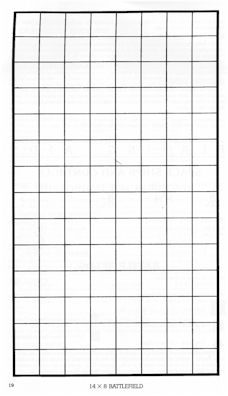
17 X 10 BATTLEFIELD GRID
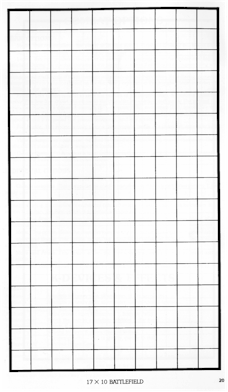
28 X 16 BATTLEFIELD GRID
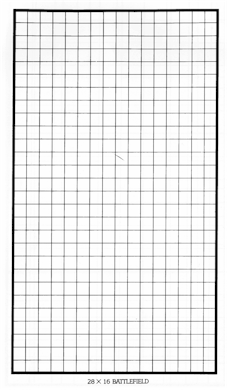
COMBAT OPTIONS
Combat options are of two types, team options and individual options.TEAM OPTIONS
Mode. This option allows the player to change from 1 player to 2 player mode and back.Surrender. This option can be used to surrender a hopeless combat.
Leave. This option allows the player to attempt to disengage from the enemy and flee the battlefield. During the combat execution, the player's leader will attempt to disengage along with the unwounded, unstunned members of his party. There is a 5% chance per leadership point that disengagement will occur. If it fails the team will simply defend themselves. If the disengagement is successful there is a chance (based on the member's experience) that any given team memberwifi be killed in the attempt.
Profile. This option is used to view the profiles of the player's team. A profile is a four line display. The first line shows the name of the character, its species, and status. The second line shows the character's adjusted strength (ST), dexterity (DX), endurance (EN). speed (SP), and sensitivity (SN). The third line shows which weapon the character has ready, the skill level in that weapon, and if it is loaded (for phasor weapons), and any armor.
Full Profile. This option is used to view the complete profile of a character, especially what they are carrying.
View Enemy. This option can be used to view the profiles of the enemy characters. These profiles don't show whether a weapon is loaded.
Choose Options. This option is used to choose options for a particular character. It transfers control to the individual options listed below.
INDIVIDUAL OPTIONS
Load weapon. This option loads phasor weapons and Heat Ray Guns and Matter Beams.Change weapons. This option can be used to transfer one of the carried items to carry-1, the ready position.
Rest. This option can be used to increase a character's endurance by one, up to its original endurance rating. If a character's endurance falls to 0 or less, no other option can be chosen. If no option is chosen, the Rest option is automatically chosen.
Standing Attack. This option can be used to attack before the movement phase of the combat turn.
Move. This option allows the character to mQve any number of squares up to its speed rating.
Move and Dodge. This option allows the character to move up to half its speed rating while dodging.
Move and Aftack. This option allows the character to move up to half its speed rating and attack.
Use. This option allows the character to use one of the special weapons or K devices.
